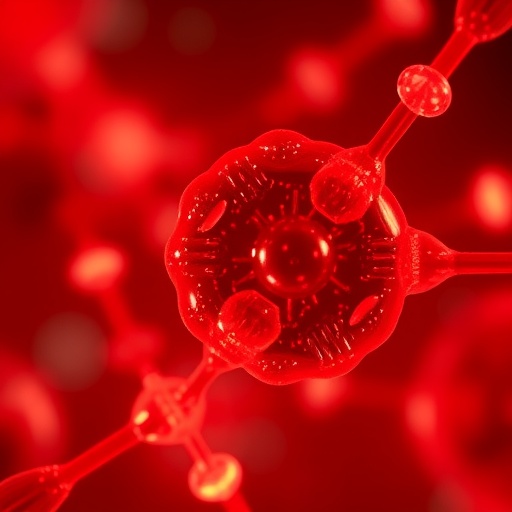In the relentless pursuit of advanced materials capable of revolutionizing biomedical applications, diradicaloids have emerged as a captivating class of compounds due to their intriguing electronic structures and exceptional photophysical properties. Among them, Chichibabin hydrocarbons have attracted significant attention owing to their robust spin-coupling effects and narrow band gaps that confer strong near-infrared (NIR) light absorption—a critical feature for photothermal therapy. Despite these properties, the broader utility of Chichibabin diradicaloids has been hampered by their intrinsic chemical instability and notoriously poor luminescence efficiencies, limiting their potential in precise biomedical imaging and therapy.
Historically, strategies to enhance the photophysical performance and stability of Chichibabin hydrocarbons have involved peripheral substitution, such as the chlorine-substituted TTM-TTM molecule. This compound demonstrated noteworthy NIR emission at 780 nm, a promising attribute for non-invasive imaging and therapy. However, its photoluminescence quantum yield (PLQY) lingered at a meager 0.8%, curtailing its effectiveness in optical imaging modalities where brightness and signal fidelity are paramount. Moreover, the delicate molecular architecture of TTM-TTM imposed constraints on its photostability, limiting its practical utility in dynamic biological environments.
Breaking new ground, a recently published study in Light: Science & Applications unveils an innovative molecular design paradigm for overcoming these longstanding challenges. Researchers led by Professors Alim Abdurahman, Xiaomin Liu, and Geyu Lu from the College of Electronic Science and Engineering at Jilin University in China have successfully engineered a novel diradicaloid—TT-CzPh. This molecule is architected by introducing a mild donor moiety, 3-substituted-9-phenyl-9H-carbazole (3PCz), into the fundamental Chichibabin hydrocarbon skeleton, effectively disrupting the alternating symmetry that characterizes the parent structure. This precise modification has yielded a stable diradicaloid with dramatically enhanced near-infrared luminescence and an outstanding photothermal conversion efficiency.
The TT-CzPh diradicaloid exhibits a photoluminescence quantum yield of 6.4%, an order of magnitude increase over TTM-TTM, signifying a robust improvement in radiative recombination efficiency. This enhancement is attributed to a reduction in electron-hole overlap upon the integration of the 3PCz donor group, which mitigates non-radiative losses by lowering vibrational relaxation pathways and simultaneously elevates the oscillator strength. The extended peripheral configuration afforded by 3PCz also confers steric protection that substantially improves photostability—approximately four times greater than that observed for TTM-TTM—thereby ensuring sustained performance under prolonged irradiation.
Beyond molecular characterization, TT-CzPh’s superior properties have been translated into a biocompatible format through the fabrication of water-soluble nanoparticles (TT-CzPh NPs). These nanoscale assemblies preserve the diradicaloid’s intrinsic photophysical attributes while imparting aqueous dispersibility, a critical requirement for in vivo biomedical applications. The nanoparticles demonstrate exceptional near-infrared imaging capability, enabling precise tumor localization in a murine 4T1 breast cancer model. Concurrently, they manifest ultra-high photothermal conversion efficiency—up to 87.5% in molecular form and 82% in nanoparticle assemblies—facilitating effective tumor ablation through localized hyperthermia upon NIR laser irradiation.
This dual functionality of TT-CzPh as both a luminescent imaging agent and potent photothermal therapeutic platform places it at the forefront of theranostic materials. Its intense NIR emission allows for deep-tissue visualization, while its heat generation capability offers targeted destruction of malignant cells, minimizing collateral damage to surrounding healthy tissue. This synergy ushers a new era for Chichibabin hydrocarbons in cancer phototherapy, overcoming previous limitations of instability and low luminescence.
The molecular design ethos embraced by the team exemplifies the power of incorporating donor units into diradical frameworks to tune electronic interactions delicately. By substituting the four peripheral chlorines in TTM-TTM with mild electron donors such as 3PCz, they successfully disrupted the alternant hydrocarbon resonance, a principle that can be extended to similar systems seeking enhanced optoelectronic properties. This approach also highlights that modest structural alterations can yield profound improvements in quantum efficiency and photostability, providing a roadmap for future functional material development.
Moreover, TT-CzPh’s enhanced photostability suggests promising longevity and repeatability of function under continuous biological operation conditions, a critical parameter for clinical translation. Stability under physiological conditions ensures that imaging and therapeutic efficacy remain uncompromised over the duration of treatment regimens, overcoming a major hurdle faced by many organic photothermal materials prone to degradation.
The in vivo performance of TT-CzPh NPs further underlines their clinical potential. Their excellent NIR fluorescence imaging facilitates precise visualization and monitoring of tumor margins, while the high photothermal conversion efficiency ensures effective thermal ablation at comparatively low laser power densities. This reduces the risk of overheating and damage to non-target tissues, thereby enhancing treatment safety profiles.
Importantly, this study sets the stage for integrating diradicaloid-based materials into multimodal theranostic platforms, combining real-time imaging with therapeutic interventions. With ongoing advancements, TT-CzPh and derivatives could be engineered to incorporate targeting ligands, stimuli-responsive groups, or combined with other therapeutic agents, creating synergistic effects that further improve cancer treatment outcomes.
Beyond cancer therapy, the unparalleled NIR absorption and emission properties of TT-CzPh may have broad implications across diverse fields such as biosensing, optoelectronics, and photovoltaics. Its stable diradical nature coupled with tailor-made electronic structures offers a versatile platform adaptable to various functional demands, bridging chemistry, materials science, and biomedical engineering.
The publication of this work in Light: Science & Applications underlines its significance to the scientific community. It showcases the profound impact of molecular engineering on material performance, pushing the boundaries of what diradicaloids can achieve in practical biomedical technologies. The collaborative efforts by Jilin University’s research team highlight the synthesis of innovative chemistry and translational medicine toward addressing pressing healthcare needs through advanced material solutions.
Ultimately, the advent of TT-CzPh marks a pivotal advance in the design of luminescent diradicaloids, merging stability, brightness, and therapeutic efficacy into a singular molecular entity. Its success underscores the transformative potential of molecular asymmetry and donor incorporation strategies for next-generation photothermal agents and bioimaging probes, promising to accelerate the development of real-world functionalities in cancer diagnostics and treatment.
Subject of Research: Development and application of stable luminescent Chichibabin diradicaloids for near-infrared imaging and photothermal therapy.
Article Title: Efficient Luminescent Stable Chichibabin Diradicaloid for Near-infrared Imaging and Photothermal Therapy.
Web References: 10.1038/s41377-025-01993-w
Image Credits: Ting Liu et al.




